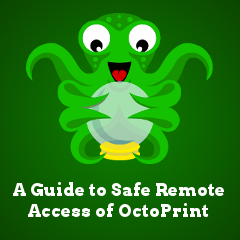3D Printing
PinkyPi Pro source files and STL files now available on Thingiverse!
I’ve released build 2.0 of PinkyPi Pro onto Thingiverse as the first public release.
PinkyPi Pro is a micro gaming handheld, themed around the SNES style controller / controls. Inlcuding A/B/X/Y, Start/Select and L/R triggers, with a 1.5inch LCD display, built in amp/speaker/charger and battery for portability.
The current build is going to be sporting a 600mAh battery, 100mAh more than the Pinky Pi standard version.
Check out the build log in our forums, and look forward to a full build video, parts kits and other goodies coming soon!

Threaded Inserts in 3D Prints – How strong are they?
CNC Kitchen tested the strength of brass threaded inserts and will compare it to cut threads and 3D printed threads. Let’s find out if it’s worth adding these metal parts to your designs!
A Guide To Safe Remote Access of OctoPrint
So, you’ve got your shiny new printer, and just installed OctoPrint, great! Being able to remotely monitor your print is a fantastic ability. Being able to start a print remotely is incredibly handy. From within the realm of your local network, you have a ton of power at your finger tips. What if you want to be able to do this when you’re not on your local network? You could just forward ports on your router, use a DDNS service, and you’re good to go, right? … wrong.
The ISC (Internet Storm Center) recently published an article about OctoPrint instances exposed to the public internet. While it is possible that a percentage of the instances found are unintentionally exposed, the vast majority is very likely users who have gone out of their way to expose OctoPrint to the public internet for the sake of convenience. There are safer ways to access your instance remotely than blind port forwarding. This is a critical issue that needs to be discussed. We as a community have to get the right information to new and/or uninformed users, to prevent a catastrophy from happening.
Putting OctoPrint onto the public internet is a terrible idea, and I really can’t emphasize that enough. Let’s think about this for a moment, or two, or even three. OctoPrint is connected to a printer, complete with motors and heaters. If some hacker somewhere wanted to do some damage, they could. Most printers can have their firmware flashed over USB. So as soon as the box hosting OctoPrint is comprimised, there go any failsafes built into the firmware. All one would have to do, is flash a new, malicious firmware with no safeguards, over USB, and then tell the printer to keep heating, leading to catastrophic failure. Of course there are other reasons to not have an OctoPrint instance available on the public internet, such as sensitive data theft, but catastrophic failure is by far the worst case scenario here.
So, with that said, how can we accomplish remote access to monitor or control a printer, without putting OctoPrint on the public internet for everyone to abuse? This guide will show you how.

3D Printing basics, How and when to service your 3D Printer.
New to 3D printing? Have you performed some typical maintenance on your printer? Here are things to look for and maintain over time to assure your prints look the best they can.
Cura Fuzzy Skin and Ironing on 3D Prints
Chuck shows you how to 3D Print Smooth or Textured surfaces using Cura Fuzzy Skin and Ironing on 3D Prints using a Creality Ender 3. These two features in Cura 3 offers you the option to 3D print a very smooth top layer or to make the outer surface textured for a good grip. He shows you how to set this up and how to use it with the ENDER 3 in this week’s Filament Friday.
Smallest 3D Printer? The Creality CR-100, is it worth it?
Naomi ‘SexyCyborg’ Wu takes a look at one of the smallest FDM printers on the market- the CR-100. It there any reason to buy small over large? Watch to find out!
There is a 3D printer review in here?
Photogrammetry 2 – 3D scanning simpler, better than ever!
Creating a 3D model just by taking lots of pictures of a real object? Yes!
Check the full article: https://www.prusaprinters.org/photogr…
Photogrammetry is back and it’s easier to use, gives better results and is still completely free!
Creality CR-10S Pro – An honest review
The Creality CR-10 has been a hugely popular 3D printer. Now the Pro model is out and you might be wondering how much of an upgrade it is. One thing is for sure, it has amazing print quality. Unfortunately, there are some problems which need addressing too. In this review, Teaching Tech takes you through features, unboxing, assembly, test prints and a recount of all of the issues I faced along the way. This printer has some fantastic points, and some that need fixing. Hopefully with the information
Teaching Tech presents it will help you make up your mind on whether you think it is a worthwhile investment.
